Editor’s note: This article was updated on 5 June 2023 to add more sections about the scrum master career, including the difference between a scrum master and a project manager, salary expectations, and information regarding transitioning careers. New images and general editorial changes were also implemented in the update.

In the world of agile project management, a scrum master plays a pivotal role in steering a team’s success. The role has become more popular in the product management world, and many have found it to be a fun and rewarding career choice.
In this guide, we’ll define the role of the scrum master, break down a scrum master’s responsibilities, and look into the skills needed to become a scrum master. We’ll also describe this person’s relationship with the other scrum roles (product owner and scrum team), offer tips, resources, and certifications to explore if you’re looking to become a scrum master, and more.
First things first, we should clarify what we mean by scrum. You can’t understand how to be a master of something without knowing what that something is!
Scrum takes its name from rugby, in which a mini-team of players (known as a scrum) huddles together to push the opponent and take control of the ball.
In agile product development, scrum describes a framework that helps huddled teams work together. Scrum promotes close collaboration, focused attention, and continuous improvement to push through development and take control of product delivery:
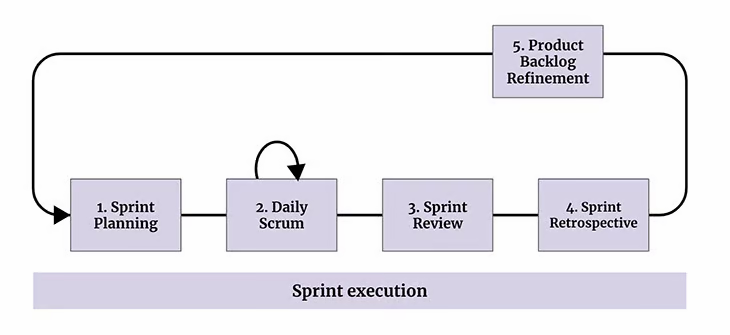
The Scrum Guide, which was written by scrum’s co-creators Ken Schwaber and Jeff Sutherland, describes the scrum framework and three specific roles therein: the product owner, scrum team, and scrum master.
In general, the scrum master’s main goal is to coach the team on the scrum framework and ensure that the team can keep getting their work done effectively. One main role of the scrum master is to make sure that the team is not being blocked by any impediments, such as a distracting work environment. The scrum master is accountable for the effectiveness of the team.
If an organization wants to use scrum as its product delivery framework, it will need to find someone dedicated to being a scrum master to ensure the team remains effective.
The scrum master, as the name implies, is there to lead the team toward success by being an expert in executing scrum. They lead many of the scrum ceremonies, such as daily scrum meetings, backlog refinement sessions, and sprint retrospectives. This involves collaborating and communicating with team members, pushing for clarity, and developing an attitude of openness and learning:
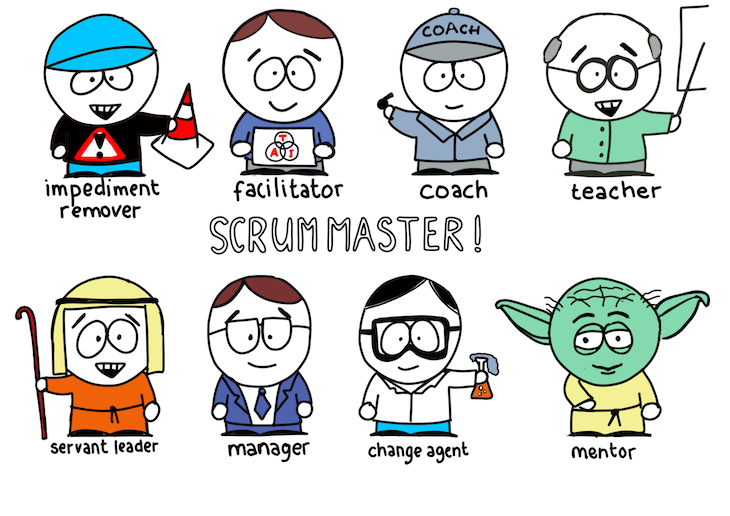
Scrum masters are often described as “servant-leaders,” dedicating their jobs to helping manage scrum teams. In summary, the scrum master’s task isn’t to manage the team in a traditional sense as a manager would. Instead, they support the team in adopting agile and scrum principles, built around self-organization and continuous improvement.
Further, the scrum master shields the team from external interruptions and takes care of any problems that arise, allowing the team to fully concentrate on the current sprint without distractions. A successful scrum master helps maintain a collaborative and respectful environment that each team member can perform their best work in.
When it comes to the day-to-day activities of a scrum master, what they do often depends on who they are working with. The scrum master’s relationship with a given role may be very different from their relationship with a different role or department:
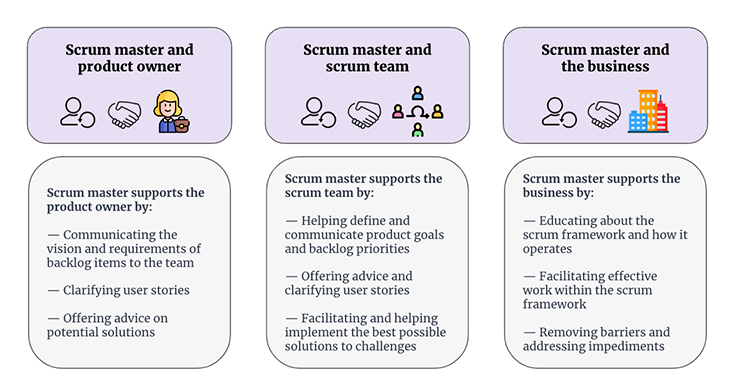
Product owners are responsible for defining the product goal and prioritizing the backlog items that are being worked on within the sprint. As such, their relationship with the scrum master is key to the scrum team’s success.
The scrum master supports the product owner by sharing this vision of product success and helping to communicate the requirements of all backlog items to the scrum team.
For example, if the scrum team isn’t clear on what a particular user story means or has a question about the best possible solution to a particular problem, the scrum master can offer advice and clarify potential approaches.
Together, the scrum master and product owner have the power to make the scrum team a roaring success or an immense failure. Therefore, their relationship is key.
The scrum team’s responsibility is to complete the user stories selected for the sprint and to deliver on the sprint goal. The scrum master is essential in facilitating this success.
The scrum master is in a position to coach the team on how to work within the scrum framework. They help curate the work included in the sprint and ensure that the expectations and desired end result are clear to all stakeholders. As a literal master of scrum, the scrum master understands how the team needs to work day in and day out to adhere to the scrum framework.
Every day, the scrum team holds a daily standup meeting where the developers on the team review if there are any impediments preventing them from doing their work. If there are, the scrum master’s job is to unblock them. Examples of impediments can be a distracting work environment, delays in decision-making or approval processes, lack of necessary equipment, or conflicts within the team.
Put simply, the scrum master’s job is to remove any impediments that threaten the team’s ability to deliver on the sprint goals in a timely manner.
As an example, if the goal is to deliver a new homepage image carousel, it would be the scrum master’s job to push the design team to deliver the images to be used in the carousel. This could involve speaking to the designer to get the image files, the design manager to sign off the design, and/or the content team to confirm the caption copy. Whatever it takes to help the scrum team stay on track and on deadline.
How does the scrum master work with the rest of the business? The interactions are similar to those we’ve already looked at with product owners and the scrum team. The difference is that they’re focused outside of the actual team.
The scrum master can take on the role of an educator, helping the business to understand the scrum framework, its benefits, and its ways of working. The more the business understands how work is delivered, the more likely it is to work within the framework itself — which will only improve the company’s ability to provide relevant KPIs, adapt to changing requirements, etc. when working interdepartmentally.
The scrum master is also responsible for removing any barriers to progress for various stakeholders throughout the business, which is why the role requires a broad range of stakeholder management skills.
The short answer is no, a scrum master is not the same as a project manager. In contrast to a scrum master, a project manager has a role that acts on the more traditional approach to getting work done. While both roles involve oversight and the coordination of team efforts, the responsibilities and goals of a scrum master and project manager are distinctly different.
A project manager typically takes on a leadership role within a more hierarchical structure. They are directly responsible for the outcome of the project, managing resources, creating and maintaining the project plan, managing risk, and making important decisions about the project. They also often serve as the main point of contact for stakeholders outside the team. The project’s success or failure generally rests on their shoulders.
On the other hand, the scrum master, as we’ve seen, operates within an agile framework where the focus is on empowering self-organizing teams. The scrum master isn’t directly responsible for the project outcome — instead, they enable the team to work effectively within the scrum framework. They don’t make decisions about the project but help guide the team in making those decisions.
In summary, while a project manager tends to be a leader and decision-maker, carrying the weight of a project’s success, a scrum master plays more of a supportive, facilitative role, ensuring the scrum team can work as efficiently and effectively as possible within the scrum framework.
| Project manager | Scrum master | |
|---|---|---|
| Role and methodology | Operates within a more traditional approach to project management | Operates within an agile scrum framework |
| Responsibility | Directly responsible for the project outcome. Manages resources, creates and maintains the project plan, manages risk, and makes important decisions | Not directly responsible for the project outcome but enables the team to work effectively within the scrum framework. They don’t make decisions about the project but help guide the team members who do |
| Leadership style | Assumes a leadership role within a hierarchical structure and serves as the main point of contact for stakeholders outside the team. Carries the weight of the project’s success or failure | Empowers self-organizing teams, playing a supportive, facilitative role, and ensures that the scrum team can work as efficiently and effectively as possible within the scrum framework |
If we were to write a scrum master job description based on the responsibilities described above, we’d end up with something like the below.
The scrum master is expected to:
As with any job, a scrum master’s salary really depends on a variety of factors, such as location, industry, company size, and the individual’s level of experience and certification.
With that said, scrum master jobs have grown in line with the overall upward trend in technology roles. In general, scrum masters generally do get paid well! While the exact figure can vary, the average salary for a scrum master in the United States has been reported to hover around $120,000. For those who have climbed the ranks to hold titles such as “senior scrum master,” they can expect an average salary closer to $145,000.
It’s important to note that these figures represent averages, and the actual salary can be higher or lower, particularly when considering additional compensation like bonuses, profit sharing, and benefits. Always do your research and make sure to look at data that filters for location, years of experience, skillset, etc. The worst thing you can do is undervalue yourself!
The pathway to becoming a scrum master is diverse and accessible to individuals from a variety of backgrounds. The most common scenario is someone in a different type of scrum role, like a product owner, transitioning into becoming a scrum master. Most scrum masters typically start in some form of project manager role, however.
These problem-solving, people-centric jobs require skills that fit neatly within a focused scrum team. However, if you’re not currently in one of these roles, there are lots of resources you can turn to for information about how to become a scrum master.
The foundational skills required for the role — such as communication, problem-solving, flexibility, and adaptability — can be developed in many contexts. Therefore, people from non-technical backgrounds such as humanities, social sciences, business, etc. could also transition into this role given the right training and experience.
In general, an important step in the journey to becoming a scrum master is understanding and gaining experience with agile methodologies, particularly scrum. This can be done through self-study, online courses, or formal training programs. Several organizations offer scrum master certifications, with the Certified Scrum Master (CSM) from the Scrum Alliance being one of the most recognized.
A great starting point is Scrum.org, the official home of the scrum framework. This site is full of information about the scrum master role and its involvement with the framework. It also gives you access to some open assessments where you can test your current knowledge levels.
Lastly, networking within the industry and joining communities of practice can provide valuable insights and opportunities. Putting time on the calendar to chat with a current scrum master and learning about their role can help give you knowledge that a course or certification won’t teach you. Aside from that, keeping up with industry trends and developing skills will never hurt.
As for the skills required to be a scrum master, a qualified candidate would be someone who is:
There are a number of scrum master certifications one can get. Having multiple scrum master certifications from different sources can showcase a broader understanding of scrum practices, but of course, each certification costs money and valuable time. Below are a list of scrum master certification and the details around them.
As we alluded to before, this is the most well-recognized scrum certification. It is made by the Scrum Alliance. The CSM course is the core level and usually involves a two-day course.
Price: $445 for the course and exam
Length of exam: 60 minutes
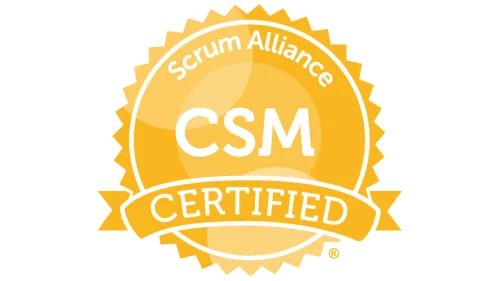
The PSM certification is the next level up from CSM. There are varying levels to it, so it’s best to start with the PSM 1 exam. You can self-study for this, as the questions focus on an understanding of scrum and agile. There are plenty of free resources online!
Price: $150 (per attempt)
Passing score: 85%
Length of exam: 60 minutes
Number of questions: 80
Format: Multiple choice, multiple answer, true/false
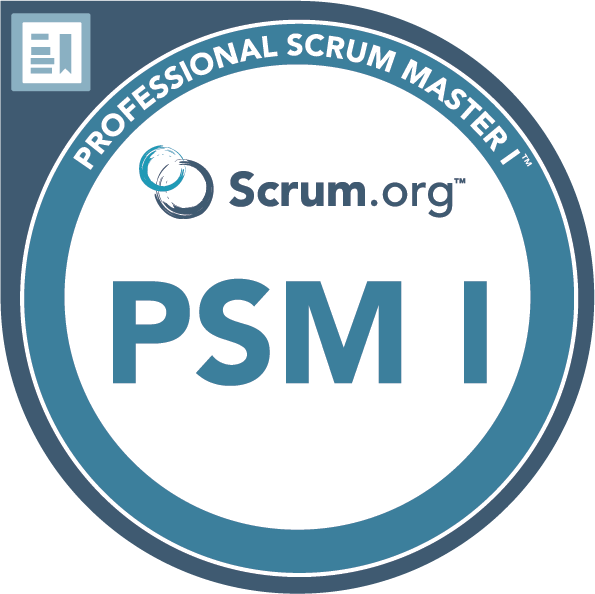
The Project Management Institute also offers certifications for project management. You do need some prerequisites to apply to take the exam, however, including having a high school diploma, associate’s degree, or four-year degree, 36 months of experience leading projects within the past eight years, etc.
You can review the full requirements here.
Price: $405 (member); $575 (non-member)
Passing score: Based on how you rank in each of the five process groups
Length of exam: 230 minutes
Number of questions: 180
Format: Multiple choice

When evaluating scrum master certification providers, you should approach it in the same way you would when choosing a product management certification. How will your competency be evaluated? What is the teaching and assessment process? Do you need to have any prior experience to sit in on the course? How much does it cost?
As with many careers, there may be opportunities to transition into the scrum master role within your existing organization. The core of this career change lies in developing a deep understanding of scrum methodologies and enhancing relevant soft skills.
If you’re currently in a project management role, you’re well-positioned to make this shift. Start by familiarizing yourself with scrum principles and practices. You could do this by self-study, attending workshops, or enrolling in online courses. You can also consider getting one of the certifications we mentioned above,
However, if you’re in a different line of work, the transition might require additional steps. Consider volunteering for cross-functional teams or projects in your current organization that use agile methodologies. This will help you gain exposure and firsthand experience with scrum practices.
Alternatively, if you’re in a technical role, you might already be working within a scrum framework. Leverage this experience and express your interest in taking up more responsibilities within your scrum team. Leading stand-up meetings or assisting in sprint planning could be good starting points.
Regardless of your starting point, building strong communication, facilitation, and conflict-resolution skills will be essential. These can be developed on the job, but also through training, mentorship, and even roles in non-work environments, like community groups or clubs. Remember, the path to becoming a scrum master is as much about mindset and soft skills as it is about understanding the scrum framework.
Dedicating one’s full-time job to the scrum framework may seem funny, but it is the core of many successful product organizations. Being a scrum master can be a very rewarding role, so if it sounds like it might be for you, I’d encourage you to give it a go.
Featured image source: IconScout

LogRocket identifies friction points in the user experience so you can make informed decisions about product and design changes that must happen to hit your goals.
With LogRocket, you can understand the scope of the issues affecting your product and prioritize the changes that need to be made. LogRocket simplifies workflows by allowing Engineering, Product, UX, and Design teams to work from the same data as you, eliminating any confusion about what needs to be done.
Get your teams on the same page — try LogRocket today.

A practical framework for PMs to use AI in ideation without sacrificing judgment, strategy, or decision quality.

A practical five minute revenue estimation method to help product managers compare ideas, drop low impact features, and prioritize smarter.

A practical guide for PMs who want to stop being bottlenecks, delegate smarter, and lead teams effectively with a clear ownership framework.

Stop letting unreliable data block features. Treat data as inventory to track quality, ownership, and ship with confidence.